哺乳动物雷帕霉素靶蛋白:神经系统治疗的新靶点
- 格式:doc
- 大小:24.00 KB
- 文档页数:2
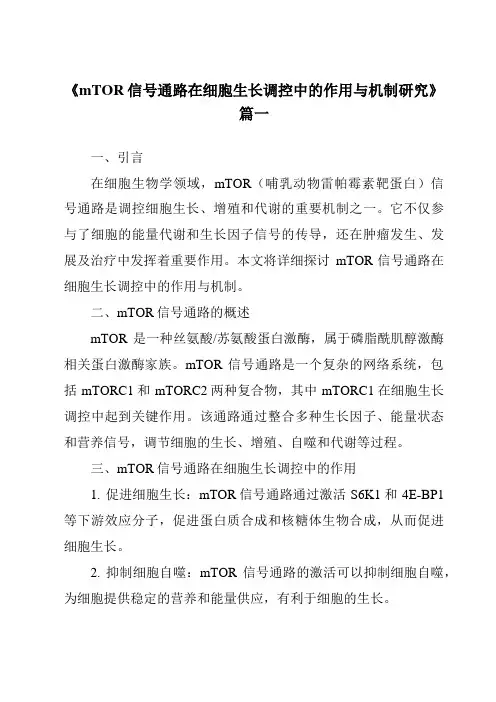
《mTOR信号通路在细胞生长调控中的作用与机制研究》篇一一、引言在细胞生物学领域,mTOR(哺乳动物雷帕霉素靶蛋白)信号通路是调控细胞生长、增殖和代谢的重要机制之一。
它不仅参与了细胞的能量代谢和生长因子信号的传导,还在肿瘤发生、发展及治疗中发挥着重要作用。
本文将详细探讨mTOR信号通路在细胞生长调控中的作用与机制。
二、mTOR信号通路的概述mTOR是一种丝氨酸/苏氨酸蛋白激酶,属于磷脂酰肌醇激酶相关蛋白激酶家族。
mTOR信号通路是一个复杂的网络系统,包括mTORC1和mTORC2两种复合物,其中mTORC1在细胞生长调控中起到关键作用。
该通路通过整合多种生长因子、能量状态和营养信号,调节细胞的生长、增殖、自噬和代谢等过程。
三、mTOR信号通路在细胞生长调控中的作用1. 促进细胞生长:mTOR信号通路通过激活S6K1和4E-BP1等下游效应分子,促进蛋白质合成和核糖体生物合成,从而促进细胞生长。
2. 抑制细胞自噬:mTOR信号通路的激活可以抑制细胞自噬,为细胞提供稳定的营养和能量供应,有利于细胞的生长。
3. 调节能量代谢:mTOR信号通路可以感知细胞的能量状态,调节葡萄糖代谢和脂质代谢,为细胞生长提供必要的能量和物质基础。
四、mTOR信号通路的机制研究mTOR信号通路的机制涉及多个层面,主要包括以下几个方面:1. 生长因子信号的传导:生长因子与受体结合后,通过一系列的信号传导过程激活mTOR信号通路。
2. 营养和能量信号的感知:mTOR信号通路可以感知细胞的营养和能量状态,根据内外环境的变化调整细胞的代谢和生长。
3. 下游效应分子的激活:mTOR信号通路的激活会引发一系列的下游效应分子如S6K1、4E-BP1等的激活,从而促进细胞的生长和代谢。
五、mTOR信号通路与疾病的关系mTOR信号通路在许多疾病的发生、发展中起着重要作用,尤其是肿瘤。
在肿瘤细胞中,mTOR信号通路的异常激活可以促进肿瘤细胞的生长、增殖和代谢,为肿瘤的发生和发展提供有利条件。
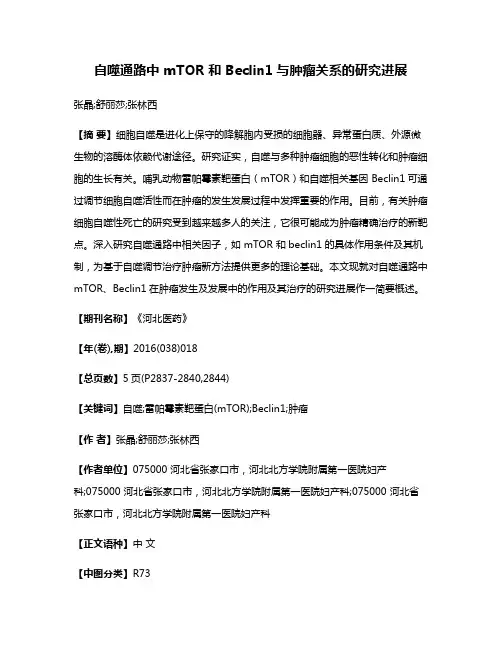
自噬通路中 mTOR 和 Beclin1与肿瘤关系的研究进展张晶;舒丽莎;张林西【摘要】细胞自噬是进化上保守的降解胞内受损的细胞器、异常蛋白质、外源微生物的溶酶体依赖代谢途径。
研究证实,自噬与多种肿瘤细胞的恶性转化和肿瘤细胞的生长有关。
哺乳动物雷帕霉素靶蛋白(mTOR)和自噬相关基因 Beclin1可通过调节细胞自噬活性而在肿瘤的发生发展过程中发挥重要的作用。
目前,有关肿瘤细胞自噬性死亡的研究受到越来越多人的关注,它很可能成为肿瘤精确治疗的新靶点。
深入研究自噬通路中相关因子,如 mTOR 和beclin1的具体作用条件及其机制,为基于自噬调节治疗肿瘤新方法提供更多的理论基础。
本文现就对自噬通路中mTOR、Beclin1在肿瘤发生及发展中的作用及其治疗的研究进展作一简要概述。
【期刊名称】《河北医药》【年(卷),期】2016(038)018【总页数】5页(P2837-2840,2844)【关键词】自噬;雷帕霉素靶蛋白(mTOR);Beclin1;肿瘤【作者】张晶;舒丽莎;张林西【作者单位】075000 河北省张家口市,河北北方学院附属第一医院妇产科;075000 河北省张家口市,河北北方学院附属第一医院妇产科;075000 河北省张家口市,河北北方学院附属第一医院妇产科【正文语种】中文【中图分类】R73由溶酶体介导的细胞内物质的降解过程,即长寿蛋白或衰老细胞器被包裹入囊泡并与溶酶体结合形成自噬溶酶体,通过最终的复杂生化作用,消化其所包裹内容物的过程被称为自噬。
其关键作用是实现细胞内环境的稳态,但由于过度激活,自噬亦可造成细胞的Ⅱ型程序性死亡。
基于这一特点,通过研究合理运用自噬的机理为肿瘤的精准性治疗提供了新的思路。
细胞自噬具有十分复杂的生理功能,主要表现为:(1)具有清除丧失功能的细胞质内成分,还可防止异常蛋白质的堆积;(2)降解产物可被再次循环利用,以合成新的生物大分子和 ATP 满足应激条件下细胞和机体代谢的需求;(3)过度上调自噬作用可以引起细胞“自噬性死亡”[1]。
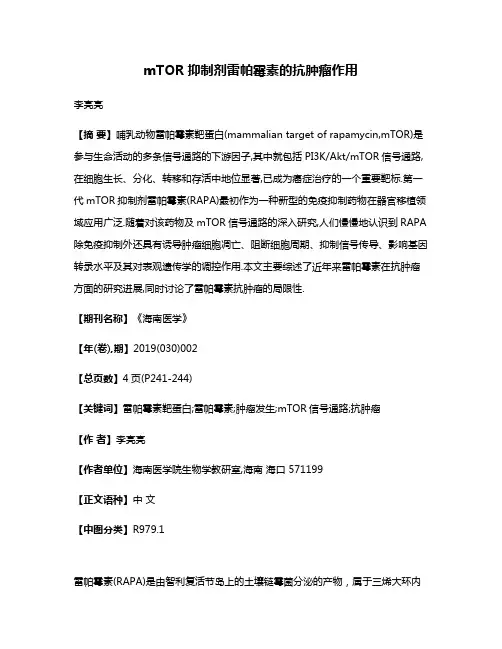
mTOR抑制剂雷帕霉素的抗肿瘤作用李亮亮【摘要】哺乳动物雷帕霉素靶蛋白(mammalian target of rapamycin,mTOR)是参与生命活动的多条信号通路的下游因子,其中就包括PI3K/Akt/mTOR信号通路,在细胞生长、分化、转移和存活中地位显著,已成为癌症治疗的一个重要靶标.第一代mTOR抑制剂雷帕霉素(RAPA)最初作为一种新型的免疫抑制药物在器官移植领域应用广泛.随着对该药物及mTOR信号通路的深入研究,人们慢慢地认识到RAPA 除免疫抑制外还具有诱导肿瘤细胞凋亡、阻断细胞周期、抑制信号传导、影响基因转录水平及其对表观遗传学的调控作用.本文主要综述了近年来雷帕霉素在抗肿瘤方面的研究进展,同时讨论了雷帕霉素抗肿瘤的局限性.【期刊名称】《海南医学》【年(卷),期】2019(030)002【总页数】4页(P241-244)【关键词】雷帕霉素靶蛋白;雷帕霉素;肿瘤发生;mTOR信号通路;抗肿瘤【作者】李亮亮【作者单位】海南医学院生物学教研室,海南海口 571199【正文语种】中文【中图分类】R979.1雷帕霉素(RAPA)是由智利复活节岛上的土壤链霉菌分泌的产物,属于三烯大环内酯类的化合物。
最初作为低毒强效的抗真菌药物和免疫抑制剂被研发出来,广泛用于抗炎和维持移植器官免疫能力。
随着科学家们对RAPA药理性质及分子机制的深入研究,人们开始认识到RAPA还具有除抗炎、免疫抑制外的多种其他药理作用,如对肿瘤细胞增殖产生抑制、提高机体免疫力、延缓衰老等作用。
近几十年来,研究发现RAPA可以影响多系统肿瘤性疾病,如消化系统、生殖系统、呼吸系统、女性生殖系统等[1-8]。
RAPA的肿瘤抑制作用受到科学家们关注,为此他们做了许多有关的研究并获得了一些成功,2007年FDA批准RAPA治疗肾癌,RAPA衍生物用于治疗肾癌、脑肿瘤、胰腺癌和乳腺癌等。
2015年FDA获批成为淋巴管肌瘤(LAM)和结节性硬化症(TAC)的治疗药物[9]。
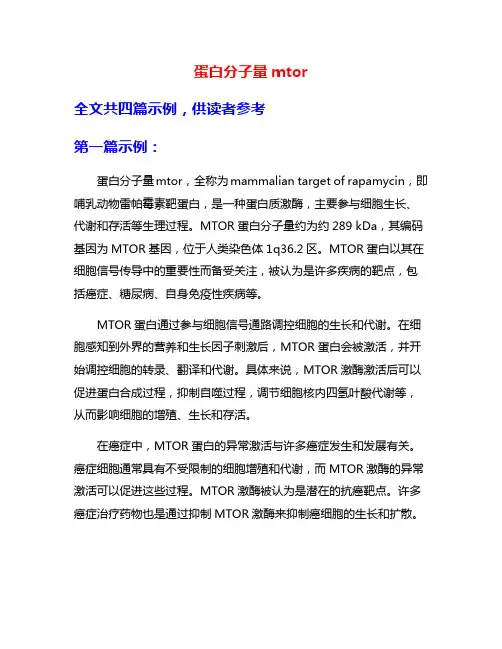
蛋白分子量mtor全文共四篇示例,供读者参考第一篇示例:蛋白分子量mtor,全称为mammalian target of rapamycin,即哺乳动物雷帕霉素靶蛋白,是一种蛋白质激酶,主要参与细胞生长、代谢和存活等生理过程。
MTOR蛋白分子量约为约289 kDa,其编码基因为MTOR基因,位于人类染色体1q36.2区。
MTOR蛋白以其在细胞信号传导中的重要性而备受关注,被认为是许多疾病的靶点,包括癌症、糖尿病、自身免疫性疾病等。
MTOR蛋白通过参与细胞信号通路调控细胞的生长和代谢。
在细胞感知到外界的营养和生长因子刺激后,MTOR蛋白会被激活,并开始调控细胞的转录、翻译和代谢。
具体来说,MTOR激酶激活后可以促进蛋白合成过程,抑制自噬过程,调节细胞核内四氢叶酸代谢等,从而影响细胞的增殖、生长和存活。
在癌症中,MTOR蛋白的异常激活与许多癌症发生和发展有关。
癌症细胞通常具有不受限制的细胞增殖和代谢,而MTOR激酶的异常激活可以促进这些过程。
MTOR激酶被认为是潜在的抗癌靶点。
许多癌症治疗药物也是通过抑制MTOR激酶来抑制癌细胞的生长和扩散。
除了癌症外,MTOR蛋白也与糖尿病、心血管疾病、自身免疫性疾病等多种疾病的发生和发展有关。
MTOR激酶已成为一个备受关注的研究对象,在药物研发和治疗方面具有很大的潜力。
MTOR蛋白是一个重要的细胞信号传导蛋白,在细胞的生长、代谢和存活等生理过程中起着关键作用。
通过研究和了解MTOR蛋白的功能和调控机制,有望为未来的疾病治疗和预防提供新的思路和方法。
希望随着科学技术的进步,人们能够更深入地了解MTOR蛋白,从而为人类健康和生活质量的提升做出更大的贡献。
第二篇示例:蛋白分子量mTOR 文章:蛋白分子量mTOR(Mechanistic Target of Rapamycin,mTOR)是一种蛋白激酶,是细胞代谢和增殖调控的关键调节因子。
mTOR蛋白分子是一种大分子,在细胞中起着重要的调节作用,对细胞的生长、增殖、代谢和自噬等过程都有重要的影响。
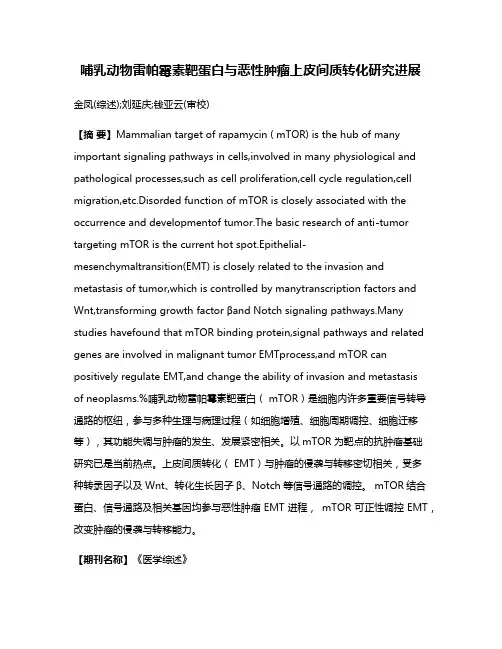
哺乳动物雷帕霉素靶蛋白与恶性肿瘤上皮间质转化研究进展金凤(综述);刘延庆;钱亚云(审校)【摘要】Mammalian target of rapamycin ( mTOR) is the hub of many important signaling pathways in cells,involved in many physiological and pathological processes,such as cell proliferation,cell cycle regulation,cell migration,etc.Disorded function of mTOR is closely associated with the occurrence and developmentof tumor.The basic research of anti-tumor targeting mTOR is the current hot spot.Epithelial-mesenchymaltransition(EMT) is closely related to the invasion and metastasis of tumor,which is controlled by manytranscription factors and Wnt,transforming growth factor βand Notch signaling pathways.Many studies havefound that mTOR binding protein,signal pathways and related genes are involved in malignant tumor EMTprocess,and mTOR can positively regulate EMT,and change the ability of invasion and metastasisof neoplasms.%哺乳动物雷帕霉素靶蛋白( mTOR)是细胞内许多重要信号转导通路的枢纽,参与多种生理与病理过程(如细胞增殖、细胞周期调控、细胞迁移等),其功能失调与肿瘤的发生、发展紧密相关。

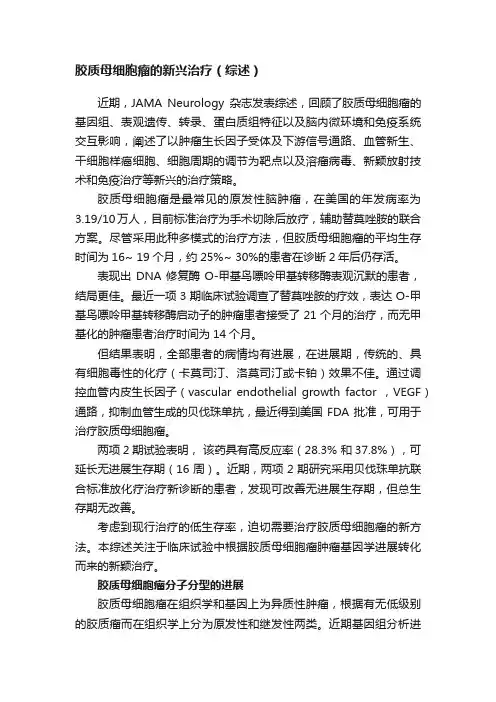
胶质母细胞瘤的新兴治疗(综述)近期,JAMA Neurology杂志发表综述,回顾了胶质母细胞瘤的基因组、表观遗传、转录、蛋白质组特征以及脑内微环境和免疫系统交互影响,阐述了以肿瘤生长因子受体及下游信号通路、血管新生、干细胞样癌细胞、细胞周期的调节为靶点以及溶瘤病毒、新颖放射技术和免疫治疗等新兴的治疗策略。
胶质母细胞瘤是最常见的原发性脑肿瘤,在美国的年发病率为3.19/10万人,目前标准治疗为手术切除后放疗,辅助替莫唑胺的联合方案。
尽管采用此种多模式的治疗方法,但胶质母细胞瘤的平均生存时间为16~ 19个月,约25%~ 30%的患者在诊断2年后仍存活。
表现出DNA修复酶O-甲基鸟嘌呤甲基转移酶表观沉默的患者,结局更佳。
最近一项3期临床试验调查了替莫唑胺的疗效,表达O-甲基鸟嘌呤甲基转移酶启动子的肿瘤患者接受了21个月的治疗,而无甲基化的肿瘤患者治疗时间为14个月。
但结果表明,全部患者的病情均有进展,在进展期,传统的、具有细胞毒性的化疗(卡莫司汀、洛莫司汀或卡铂)效果不佳。
通过调控血管内皮生长因子(vascular endothelial growth factor ,VEGF)通路,抑制血管生成的贝伐珠单抗,最近得到美国FDA批准,可用于治疗胶质母细胞瘤。
两项2期试验表明,该药具有高反应率(28.3% 和37.8%),可延长无进展生存期(16周)。
近期,两项2期研究采用贝伐珠单抗联合标准放化疗治疗新诊断的患者,发现可改善无进展生存期,但总生存期无改善。
考虑到现行治疗的低生存率,迫切需要治疗胶质母细胞瘤的新方法。
本综述关注于临床试验中根据胶质母细胞瘤肿瘤基因学进展转化而来的新颖治疗。
胶质母细胞瘤分子分型的进展胶质母细胞瘤在组织学和基因上为异质性肿瘤,根据有无低级别的胶质瘤而在组织学上分为原发性和继发性两类。
近期基因组分析进一步支持了该假说:原发性和继发性反映着不同的肿瘤成因。
原发性胶质母细胞瘤是该病最常见的类型,而原发性胶质母细胞瘤最常见的基因突变位点为端粒酶逆转录酶基因(TERT; OMIM 187270)的启动子区,该突变见于54%~ 83%的肿瘤。
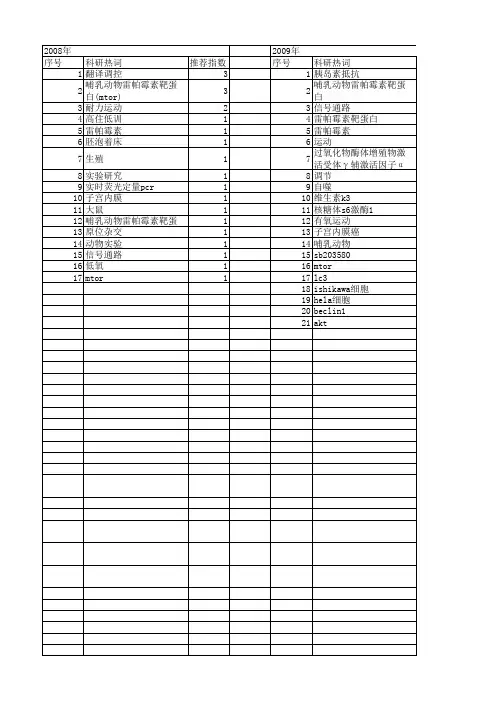
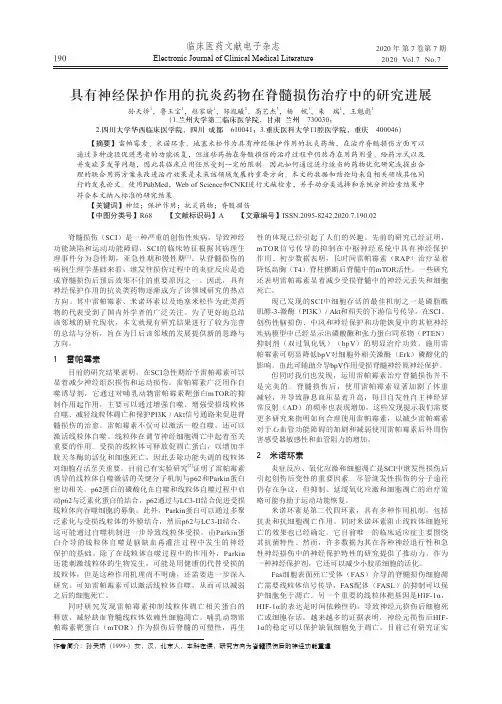
临床医药文献电子杂志Electronic Journal of Clinical Medical Literature2020 年 第 7 卷第 7 期2020 Vol.7 No.7190具有神经保护作用的抗炎药物在脊髓损伤治疗中的研究进展孙天娇1,鲁玉宝1,赵家瑜1,邹胤曦2,高艺杰3,杨 帆1,朱 瑞1,王魁彪1(1.兰州大学第二临床医学院,甘肃 兰州 730030;2.四川大学华西临床医学院,四川 成都 610041;3.重庆医科大学口腔医学院,重庆 400046)【摘要】雷帕霉素、米诺环素、地塞米松作为具有神经保护作用的抗炎药物,在治疗脊髓损伤方面可以通过多种途径促进患者的功能恢复,但这些药物在脊髓损伤的治疗过程中仍然存在用药剂量、给药方式以及并发症多发等问题,因此其临床应用任然受到一定的限制。
因此如何通过进行适当的药物优化研究或提出合理的联合用药方案来改进治疗效果是未来该领域发展的重要方向。
本文的数据和结论均来自相关领域其他同行的发表论文。
使用PubMed ,Web of Science 和CNKI 进行文献检索,并手动分类选择和系统分析检索结果中符合本文纳入标准的研究结果。
【关键词】神经;保护作用;抗炎药物;脊髓损伤【中图分类号】R68 【文献标识码】A 【文章编号】ISSN.2095-8242.2020.7.190.02脊髓损伤(SCI )是一种严重的创伤性疾病,导致神经功能缺陷和运动功能障碍,SCI 的临床特征根据其病理生理事件分为急性期,亚急性期和慢性期[1]。
从脊髓损伤的病例生理学基础来看,继发性损伤过程中的炎症反应是造成脊髓损伤后预后效果不佳的重要原因之一。
因此,具有神经保护作用的抗炎类药物逐渐成为了该领域研究的热点方向。
其中雷帕霉素、米诺环素以及地塞米松作为此类药物的代表受到了国内外学者的广泛关注。
为了更好地总结该邻域的研究现状,本文就现有研究结果进行了较为完善的总结与分析,旨在为日后该邻域的发展提供新的思路与方向。
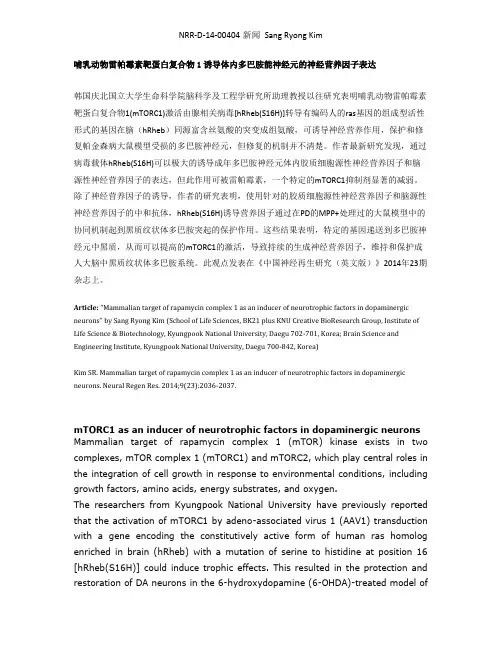
哺乳动物雷帕霉素靶蛋白复合物1诱导体内多巴胺能神经元的神经营养因子表达韩国庆北国立大学生命科学院脑科学及工程学研究所助理教授以往研究表明哺乳动物雷帕霉素靶蛋白复合物1(mTORC1)激活由腺相关病毒[hRheb(S16H)]转导有编码人的ras基因的组成型活性形式的基因在脑(hRheb)同源富含丝氨酸的突变成组氨酸,可诱导神经营养作用,保护和修复帕金森病大鼠模型受损的多巴胺神经元,但修复的机制并不清楚。
作者最新研究发现,通过病毒载体hRheb(S16H)可以极大的诱导成年多巴胺神经元体内胶质细胞源性神经营养因子和脑源性神经营养因子的表达,但此作用可被雷帕霉素,一个特定的mTORC1抑制剂显著的减弱。
除了神经营养因子的诱导,作者的研究表明,使用针对的胶质细胞源性神经营养因子和脑源性神经营养因子的中和抗体,hRheb(S16H)诱导营养因子通过在PD的MPP+处理过的大鼠模型中的协同机制起到黑质纹状体多巴胺突起的保护作用。
这些结果表明,特定的基因递送到多巴胺神经元中黑质,从而可以提高的mTORC1的激活,导致持续的生成神经营养因子,维持和保护成人大脑中黑质纹状体多巴胺系统。
此观点发表在《中国神经再生研究(英文版)》2014年23期杂志上。
Article: "Mammalian target of rapamycin complex 1 as an inducer of neurotrophic factors in dopaminergic neurons" by Sang Ryong Kim (School of Life Sciences, BK21 plus KNU Creative BioResearch Group, Institute of Life Science & Biotechnology, Kyungpook National University, Daegu 702-701, Korea; Brain Science and Engineering Institute, Kyungpook National University, Daegu 700-842, Korea)Kim SR. Mammalian target of rapamycin complex 1 as an inducer of neurotrophic factors in dopaminergic neurons. Neural Regen Res. 2014;9(23):2036-2037.mTORC1 as an inducer of neurotrophic factors in dopaminergic neurons Mammalian target of rapamycin complex 1 (mTOR) kinase exists in two complexes, mTOR complex 1 (mTORC1) and mTORC2, which play central roles in the integration of cell growth in response to environmental conditions, including growth factors, amino acids, energy substrates, and oxygen.The researchers from Kyungpook National University have previously reported that the activation of mTORC1 by adeno-associated virus 1 (AAV1) transduction with a gene encoding the constitutively active form of human ras homolog enriched in brain (hRheb) with a mutation of serine to histidine at position 16 [hRheb(S16H)] could induce trophic effects. This resulted in the protection and restoration of DA neurons in the 6-hydroxydopamine (6-OHDA)-treated model ofPD. In addition to the induction of neurotrophic factors, our results using neutralizing antibodies against GDNF and BDNF have shown that Rheb(S16H)-induced trophic factors contribute to the protection of nigrostriatal DA projections via a synergetic mechanism in the MPP+-treated rat model of PD (Nam et al., 2014). These results suggest that a specific gene delivery to DA neurons in the SN, which can enhance the activation of mTORC1, results in the sustained production of diverse neurotrophic factors that are involved in the maintenance and protection of the nigrostriatal DA system in the adult brain. In conclusion, hRheb(S16H) has robust trophic and protective effects on nigrostriatal DA projections in the adult brain. The sustained production of GDNF and BDNF via an mTORC1-dependent pathway contributes to neuroprotection in animal models of PD (Nam et al., 2014). Similar to these effects, naringin can induce the production of GDNF in adult DA neurons, highlighting it as a therapeutic agent against neurodegeneration through mTORC1 activation (Leem et al., 2014). Although more research is necessary to support these results and to optimize treatment methods, our observations suggest that activation of mTORC1 by specific gene delivery or treatment with specific compounds can induce the production of neurotrophic factors, such as GDNF and BDNF, in DA neurons. This may be a useful strategy to protect and maintain the nigrostriatal DA system in the adult brain.Article: "Mammalian target of rapamycin complex 1 as an inducer of neurotrophic factors in dopaminergic neurons" by Sang Ryong Kim (School of Life Sciences, BK21 plus KNU Creative BioResearch Group, Institute of Life Science & Biotechnology, Kyungpook National University, Daegu 702-701, Korea; Brain Science and Engineering Institute, Kyungpook National University, Daegu 700-842, Korea)Kim SR. Mammalian target of rapamycin complex 1 as an inducer of neurotrophic factors in dopaminergic neurons. Neural Regen Res. 2014;9(23):2036-2037.。
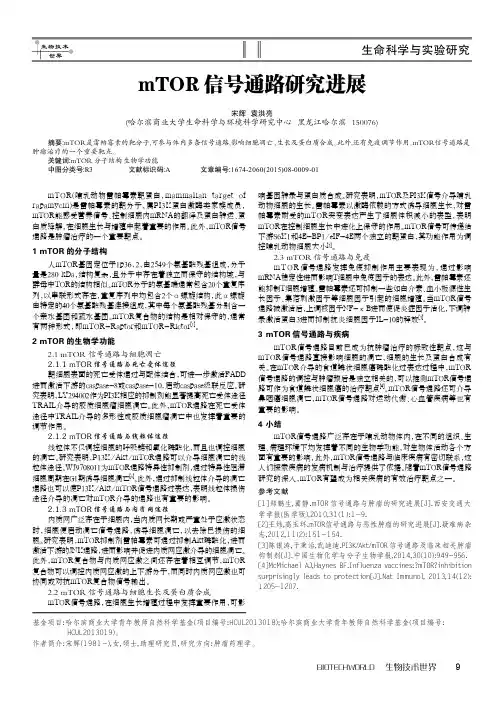
9BIOTECHWORLD 生物技术世界mTOR(哺乳动物雷帕霉素靶蛋白,mammalian target of rapamycin)是雷帕霉素的靶分子,属PI3K蛋白激酶类家族成员,mTOR能感受营养信号、控制细胞内mRNA的翻译及蛋白转运、蛋白质降解,在细胞生长与增殖中起着重要的作用。
此外,mTOR信号通路是肿瘤治疗的一个重要靶点。
1 mTOR 的分子结构人mTOR基因定位于1p36.2,由2549个氨基酸残基组成,分子量是280 kDa,结构复杂,且分子中存在着独立而保守的结构域,与酵母中TOR的结构相似。
mTOR分子的氨基端通常包含20个重复序列,以串联形式存在,重复序列中均包含2个α螺旋结构,此α螺旋由特定的40个氨基酸残基连接组成,其中每个氨基酸残基分别含一个亲水基团和疏水基团。
mTOR复合物的结构是相对保守的,通常有两种形式,即mTOR-Raptor和mTOR-Rictor [1]。
2 mTOR 的生物学功能2.1 mTOR 信号通路与细胞凋亡2.1.1 mTOR 信号通路与死亡受体途径靶细胞表面的死亡受体通过与配体结合,可进一步激活FADD 进而激活下游的caspase-8或caspase-10,启动caspase级联反应。
研究表明,LY294002作为PI3K相应的抑制剂能显著提高死亡受体途径TRAIL介导的胶质细胞瘤细胞凋亡。
此外,mTOR通路在死亡受体途径中TRAIL介导的多形性成胶质细胞瘤凋亡中也发挥着重要的调节作用。
2.1.2 mTOR 信号通路与线粒体途径线粒体不仅调控细胞的呼吸链和氧化磷酸化,而且也调控细胞的凋亡。
研究表明,P13K/Akt/mTOR通路可以介导细胞凋亡的线粒体途径。
WJ9708011为mTOR通路特异性抑制剂,通过特异性阻滞细胞周期在G1期诱导细胞凋亡[6]。
此外,通过抑制线粒体介导的凋亡通路也可以使P13K/Akt/mTOR信号通路过表达,表明线粒体损伤途径介导的凋亡对mTOR介导的通路也有重要的影响。
mTOR抑制剂的研究进展1 mTOR概述mTOR(哺乳动物雷帕霉素靶蛋白)是蛋白激酶家族中新的一员,这类蛋白激酶又属于磷酯酰肌醇激酶相关激酶(PIKK)[1-3]。
mTOR是在研究免疫抑制剂雷帕霉素的过程中发现的,科学家在研究中发现结构相似的免疫抑制剂FK506和雷帕霉素能够与相同的靶蛋白FKBP12 (FK506结合蛋白)结合发挥其免疫抑制作用,但是它却与FK506的免疫抑制机制不同,雷帕霉素与FKBP12结合形成的复合物不能与钙调素结合,并且雷帕霉素也不能抑制T细胞的早期激活或直接减少细胞因子的合成,它是通过不同的细胞因子受体阻断信号传导,阻断T淋巴细胞及其它细胞由G1期至S期的进程,而FK506则是抑制T淋巴细胞由G0期至G1期的增殖[4]。
由于mTOR在细胞增殖、分化、转移和存活中的重要地位,mTOR已经成为癌症治疗中的一个新靶点。
mTOR抑制剂的抗癌机制都是通过首先与FKBP-12蛋白生成复合物,此复合物再与mTOR的FRB区域结合由此抑制mTOR的功能,从而抑制了下游的相关因子的功能,将肿瘤细胞阻滞于G1期(前DNA合成期)从而使肿瘤细胞的生长受抑制并最终阻滞细胞的增殖甚至使细胞凋亡。
2 mTOR抑制剂2.1 雷帕霉素及其衍生物雷帕霉素(Rapamycin,Sirolimus,RAPA,1)属大环内酯类抗生素,与FK506结构相似。
早在1975年,从们已从吸水链霉菌(Steoptomyces hyproscopicus)的代谢产物中分离出雷帕霉素,但由于其过低的抗菌活性而遭冷遇,直至1977年由于其结构与免疫抑制剂FK506相似而被发现同样具有免疫抑制活性,但令人惊奇的是雷帕霉素与FK506却有着非常不同的免疫抑制机制,这也加深了人们对T细胞活化的理解。
1989年雷帕霉素作为抗移植的排斥反应的新药进入临床,现已上市。
在上世纪90年代中期,由于雷帕霉素对T淋巴细胞增殖的抑制又引导人们将其用于抗肿瘤细胞治疗,并发现其同样具有较好的抗肿瘤活性,此药作为抗癌药已由美国惠氏公司开发即将进入临床[5]。
PI3K、p-mTOR蛋白表达水平对早期诊断评估帕金森发病及预后特异性、敏感性分析吴文波;王超;牛德旺;胡超胜【摘要】目的对不同预后的帕金森病患者资料进行回顾性分析,研究帕金森病(PD)患者血清磷脂酰肌醇3激酶(PI3K)、哺乳动物雷帕霉素靶蛋白(p-mTOR)水平与疾病发生、发展及转归的关系.方法选取2014年1月至2017年6月来我院诊断为帕金森病的160例患者及同期160例健康体检者的临床资料进行回顾性分析,按照是否患有帕金森病分为对照组和PD组,并按照帕金森评分表(UPDRS)分为预后良好组(UPDRS<35)和预后不良组(UPDRS≥35),采用双抗体夹心酶联免疫吸附法(ELISA)法对各组受检者血液标本中PI3K、p-mTOR蛋白的表达情况,比较各组均值并确定指标异常的检验标准.结果与对照组相比,PD患者组血清中PI3K、p-mTOR蛋白水平明显升高(9.66±2.76 vs 3.12±0.34,5.76±0.23 vs 1.54±0.14),差异有统计学意义(P<0.05).预后良好组的PI3K、p-mTOR蛋白表达量明显低于预后不良组,差异具有统计学意义(P<0.05).PI3K、p-mTOR蛋白水平与帕金森病预后评分之间均呈正相关(r=0.811,P<0.05;r=0.734,P<0.05).(结果部分不全,请将正文2.1部分的结果加进去.否则结论中就不能提到PI3K、p-mTOR蛋白水平与帕金森病发病有相关性.)结论血清PI3K、p-mTOR蛋白水平与帕金森病发病、预后均有相关性,血清PI3K、p-mTOR蛋白水平可以作为帕金森病的早期诊断和预后评估的有效指标.【期刊名称】《实验与检验医学》【年(卷),期】2018(036)004【总页数】3页(P582-584)【关键词】帕金森病;清磷脂酰肌醇3激酶;哺乳动物雷帕霉素靶蛋白;相关性;预后【作者】吴文波;王超;牛德旺;胡超胜【作者单位】安阳地区医院神经内科,河南安阳 455000;安阳地区医院神经内科,河南安阳 455000;安阳地区医院神经内科,河南安阳 455000;安阳地区医院神经内科,河南安阳 455000【正文语种】中文【中图分类】R446.11+2;R141帕金森病的发生主要考虑与遗传、环境等因素有关,疾病的发生发展可以导致患者神经系统功能退化等临床症状的发生 [1]。
哺乳动物雷帕霉素靶蛋白及其抑制剂在乳腺癌临床诊治中的应
用进展
王俊男;王一然;李恒宇;徐拯
【期刊名称】《中国临床医学》
【年(卷),期】2018(025)004
【摘要】PI3K-Akt-mTOR信号通路异常激活在乳腺癌的发生发展中发挥重要作用,也与乳腺癌内分泌治疗及靶向治疗耐药密切相关.mTOR位于该细胞信号通路的下游,与肿瘤细胞的转录、翻译、增殖、代谢和转移等行为密切相关.mTOR抑制剂通过不同的靶点作用于PI3K-Akt-mTOR信号通路,恢复内分泌治疗的敏感性,从而发挥其抗癌作用.本文就mTOR、mTOR抑制剂及PI3K-Akt-mTOR信号通路在乳腺癌中的最新研究进展作一综述.
【总页数】6页(P649-654)
【作者】王俊男;王一然;李恒宇;徐拯
【作者单位】海军军医大学基础医学院,上海200433;海军军医大学附属长海医院肿瘤科,上海200433;海军军医大学附属长海医院甲状腺乳腺外科,上海200433;海军军医大学科研学术处,上海200433
【正文语种】中文
【中图分类】R737.9
【相关文献】
1.第三代芳香化酶抑制剂在乳腺癌术后辅助治疗中的应用进展 [J], 徐兵河
2.哺乳动物雷帕霉素靶蛋白抑制剂用于多重靶向治疗耐药的HER-2阳性晚期乳腺癌一例 [J], 边莉;郭芸菲;张会强;王涛;江泽飞
3.磷脂酰肌醇3-激酶/哺乳动物雷帕霉素靶蛋白抑制剂在乳腺癌治疗中的研究进展[J], 张晟;张霄蓓;张瑾
4.抗HER2酪氨酸激酶抑制剂在脑转移乳腺癌中的应用进展 [J], 张雪梅; 田武国; 张晓华
5.哺乳动物雷帕霉素靶蛋白抑制剂在心脏移植中的应用研究进展 [J], 左一凡;吴琪;王志维
因版权原因,仅展示原文概要,查看原文内容请购买。
哺乳动物雷帕霉素靶蛋白:神经系统治疗的新靶点美国神经科学细胞及分子信号研究实验室Kenneth Maiese博士,在《中国神经再生研究》(英文版)杂志2015年10卷第4期探讨了如何通过生长因子、Wnt信号及WISP1和干细胞组织防止糖尿病神经系统并发症的问题。
营养因子,如胰岛素样生长因子-1、成纤维细胞生长因子、表皮生长因子和促红细胞生成素,可以通过控制氧化应激和糖尿病中葡萄糖稳态防止神经元死亡。
有趣的是最近的研究也表明,细胞因子和生长因子促红细胞生成素通过Wnt信号保护间充质干细胞防止血管损伤死亡有关的途径,促进神经系统免疫细胞起到保护作用。
通过独立的途径,Wnt信号和WISP1通过促进干细胞的生长和迁移,增加胰细胞增殖,从而导致新的血管生长,修复糖尿病伤口,并控制关键的程序性细胞死亡途径促进糖尿病期间保护神经系统中的细胞凋亡和自噬。
在下游区,Wnt信号和WISP1通过雷帕霉素和AMP途径维持葡萄糖稳态和正常代谢活化的蛋白激酶。
Maiese博士还强调了通过注意“这些生物系统的活化程度是通过设计是营养因子、Wnt信号、WISP1治疗糖尿病保护神经系统时所必须考虑的。
例如,Wnt信号、WISP1和生长因子可导致如血管渗漏的视网膜和视力损害甚至癌症。
总之,神经系统生长因子、Wnt信号和WISP1具有治疗糖尿病的并发症的广阔前景,然而,如何精确应用这些途径的靶点成功的保护修复神经系统及神经元的功能仍值得探讨。
Article: "Novel applications of trophic factors, Wnt and WISP for neuronal repair and regeneration in metabolic disease" by Kenneth Maiese (Cellular and Molecular Signaling, Newark, New Jersey 07101, USA)Maiese K (2015) Novel applications of trophic factors, Wnt and WISP for neuronal repair and regeneration in metabolic disease. Neural Regen Res 10(4):518-528.欲获更多资讯:文章全文请见:Neural Regen ResNew Prospects for Targeting Diabetes Mellitus with Trophic Factors, Wnt, and WISP SUMMARYDiabetes mellitus (DM) affects almost 350 million individuals throughout the world and leads to significant disability in the nervous system involving dementia, stroke, neuropathy, and retinal disease. To combat these detrimental effects of DM, new avenues of discovery are being pursued that target novel growth factors and specific cellular pathways of Wnt signaling, Wnt1 inducible signaling pathway protein 1 (WISP1), and stem cells to block neuronal death and potentially lead to reparative processes in the nervous system.NEWS RELEASEDr. Kenneth Maiese, an expert in cellular signaling and a physician scientist, explores in the journal Neural Regeneration Research(Vol. 10, No. 4, 2015) how novel targeting with growth factors, Wnt, WISP1, and stem cell tissue regeneration may offer new strategies to prevent the complications of DM in the nervous system. Trophic factors that include insulin-like growth factor-1 (IGF-1), fibroblast growth factor (FGF), epidermal growth factor (EGF), anderythropoietin (EPO) can each control glucose homeostasis and prevent neurons from dying during the insults of oxidative stress and DM. Interestingly, recent studies also have revealed that the cytokine and growth factor EPO uses Wnt signaling to the preserve mesenchymal stem cells, protect against vascular injury, block “death-related” pathways, and promote immune cell protection of the nervous system. Through independent pathways, Wnt signaling and WISP1 promote protection in the nervous system during DM by fostering stem cell growth and migration, increasing pancreatic -cell proliferation, leading to new blood vessel growth, repairing diabetic wounds, and controlling critical programmed cell death pathways of apoptosis and autophagy. Further downstream, Wnt and WISP1 assist to maintain glucose homeostasis and normal metabolism through the pathways of the mechanistic target of rapamycin (mTOR) and AMP activated protein kinase (AMPK). Maiese also emphasizes the complexity of trophic factors, Wnt, and WISP1 in designing strategies to protect the nervous system by noting “the degree of activation of these biological systems is an important consideration in developing therapies for DM”. For example, Wnt, WISP1, and growth factors can lead to complications such as vascular leakage in the retina and impair vision as well as lead to cancer is some systems of the body. Pathways such as AMPK also have the potential to lead to the death of pancreatic islet cells under some circumstances. Overall the prospects for developing new therapeutic strategies for the complications of DM in the nervous system with growth factors, Wnt, and WISP1 are met with great enthusiasm but require precise targeting of these pathways to bear clinical success for neuronal protection, repair, and regeneration in the nervous system.Article: "Novel applications of trophic factors, Wnt and WISP for neuronal repair and regeneration in metabolic disease" by Kenneth Maiese (Cellular and Molecular Signaling, Newark, New Jersey 07101, USA)Maiese K (2015) Novel applications of trophic factors, Wnt and WISP for neuronal repair and regeneration in metabolic disease. Neural Regen Res 10(4):518-528.。